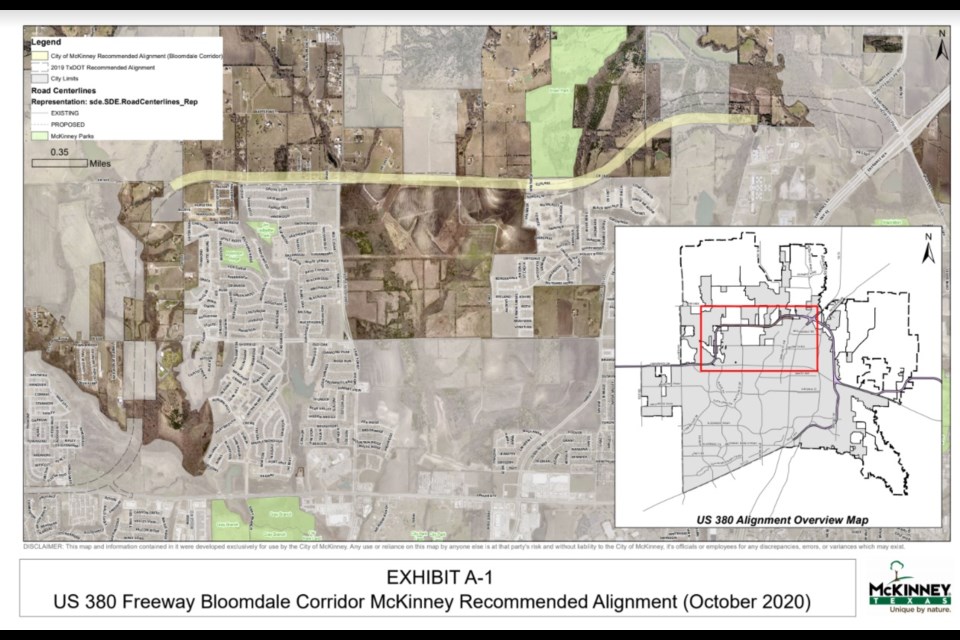A year has passed since McKinney, Collin County, the North Texas Municipal Water District, and the Texas Department of Transportation began working on where exactly to put the “footprint” of the future 380 alignment.
The two areas primarily discussed at Monday's commissioners court meeting: along the U.S. 380 corridor, an area fairly populated with people and businesses; and in the Bloomdale corridor, an area not as populated as the U.S. 380 corridor.
“There is no alternative alignment for this segment between the future Ridge Road and approximately Community Avenue (other than along the existing US 380 alignment which the City of McKinney has gone on record opposing),” Engineering Director Clarence Daugherty wrote in his Jan. 4 report to Commissioners Court. “Therefore, the staffs of the City of McKinney and Collin County are confident that the ‘footprint’ depicted in the attached illustrations will be the alignment.
“It is urgent that the land for this segment be acquired as soon as possible because there are developments along this alignment that are plotting their residential development and will build houses in this alignment if the land is not acquired from them soon,” Daugherty added. “In addition the NTMWD needs to install a large water supply line to the City of McKinney as soon as possible for the City to be able to adequately serve their growing population. The easement that they need is part of the alignment that has been established.”
On Monday, Collin County commissioners postponed their vote to purchase land, in some cases, with eminent domain until the Jan. 25 commissioners court meeting after TxDot holds its public scoping meeting on Jan. 21.
“We need to walk through the conversation together so we can say we did so with integrity even if it doesn’t change our votes,” Collin County Judge Chris Hill said.
Eminent domain woes
At Monday’s meeting, McKinney Mayor George Fuller reiterated that U.S. 38o corridor is not feasible for TxDOT.
“[It] undoubtedly would require many, many, many, many, many times the use of eminent domain,” Mayor Fuller said. “They’ve made it very clear that they have no interest in selling their properties voluntarily.”
Judge Hill followed by asking if the city supported the western segment for the bypass even if it remains entirely in the city.
Mayor Fuller said, "Yes, we do." He pointed out that they have voiced what they would like to see happen with the western portion.
“So the position of the city is to pursue the northern route of the western segment," Judge Hill said. "But if that doesn’t come to pass, the city would still prefer the bypass?”
“Given absolutely no other option, yes, it would be the lesser of two evils,” Mayor Fuller said.
Judge Hill followed Mayor Fuller's statement with his own about the months spent developing this project. “My preference at that time was if we are going to have to use eminent domain for one of these routes, I’d rather it be on the current route where people knew that they were building their businesses on a highway, on a federal highway versus folks who were miles removed from that federal highway. I was very clear that that was my preference.
Hill said that the city, county, and state stakeholders claimed the U.S. 380 corridor simply wasn't realistic. "So personally, I’m not willing to let my personal preference stop a highway that is needed by a million people. I’m absolutely able to put my personal preference aside and support a project.”
Landowner options
Judge Hill discussed with commissioners some possible options if an unwilling landowner forced them to use eminent domain. One option included allowing homestead landowners to remain at their home lease free for up to five years if they willingly sold their land to the county.
Daugherty told Hill that they could do so since portions of the alignment won’t be completed all at once. He also mentioned that they had already done something similar with other landowners.
Precinct 1 Commissioner Susan Fletcher supported the idea. “We have a lot of discretion for how we purchase land.”
Judge Hill then asked commissioners if they could postpone their vote to start purchasing land until the Jan. 25 meeting. After all, TxDot could change their mind once they completed the environmental impact study. He figured it was best to wait, which would give residents time to chime in.
The commissioners agreed to hold off on their vote.
“We know up front that there will be folks no matter where the highway goes -- I don’t know what color, or what name it will have... but somebody, somewhere will not be thrilled with it,” Judge Hill said. “We know that and we take that with absolute seriousness. But we also know that we have to plan for our entire community; so if we walk through this together with our entire community, we do ourselves a great service and a great favor.”




